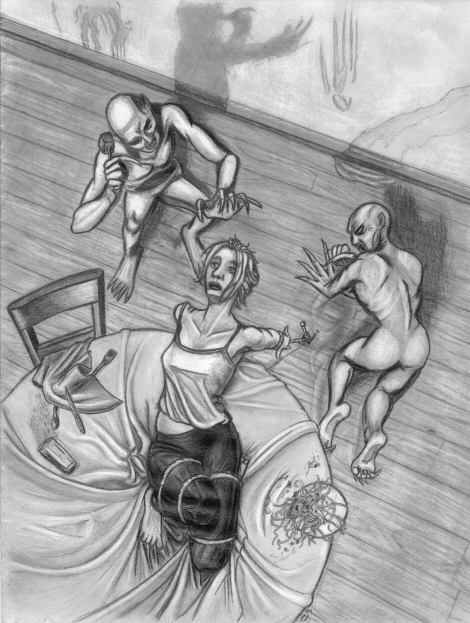 A Feast of Flesh and Fear. This time, I actually did not set out to draw something messed up. I actually set out to draw a female figure twisting in a more dynamic natural pose because often times we artists tend to make figures look stiff and rigid. Giving it just a bit of a twist or a turn or an arc of the back helps give the figure a touch of life. So I started out with just the basic framework of the torso and hips, and then came time to decide, “what about the arms?” And that is when it started going downhill. But let me pause to state that there are only two common threads running through this image (three if you count “it’s wrong.”) First, from a technical perspective, it’s more interesting and challenging than anything else I’ve illustrated here on Dark Side of the Soul. Second, I had a lot of negative space. What to populate it with? See the first thread. Okay, with that in mind, let’s continue the journey that yielded a poor girl in a horrific situation. So I had a twisting female torso, now how do I draw her arms? “Well, I’ve really never done anything with heavy foreshortening ... what if something were pulling her arms back? Way back?” Which naturally lead to “what could be pulling her arms behind her like that?” Originally, I thought some goons would be holding her while their boss towered over her, touching her chin and tilting her head up as if she pissed off the wrong person and was about to get the snot beaten out of her (they’re equal opportunity goons.) Then it came time to draw her legs, and I asked myself, “what position would they be in?” And as I lightly penciled in some possibilities, it donned on me that having her standing or even on her knees like I originally envisioned (and drew her) wouldn’t work. She’s positioned all wrong for that. And then it hit me! “What if she’s being held down? That would make it a dramatic overhead angle—which I haven’t done before—and the other figures would have to be foreshortened as well! But wait! What is she being held down on?” And so on and so on ... Fast forward a little ways (couple weeks, an hour at a time at lunch), I had a blank floor and a blank wall whose magical powers combined to make the image look flat. “This needs texture,” I said, “and a lot of it.” But what kind of textures? Hmm ... The floor started out as tile, using a straight edge to get the full grid in there; however, I couldn’t decide what kind—checkered? Patterned? Should they be small tiles tightly packed together or bigger tiles with space filled by grout? Should the tiles be light or dark or a medium shade? I couldn’t decide. And when I went to darken the grid, naturally I did all the lines in one direction at the same time (instead of darkening each individual square), and after I had about three or four rows, it occurred to me, “wood floor. Grain. Can be stained, polyurethaned1, and buffed for reflections. Problem solved. Next!” The wall was still pretty blank, but walls usually are. I think I’m just about done—oh yeah, the big blank round thing my main focal point is lying on. Yeah, I need to do something with that too. Well, it wasn’t completely blank. It’s kinda comical actually. I had the knocked over cup with its contents having splashed at a slightly different angle because cups on their side can roll to a different position. I had silverware tucked in and around a discarded napkin to give a sense of depth and verisimilitude because utensils tend to fall and scatter wherever. I even had the plate precariously positioned at the edge of the table with the weight of the spaghetti and meatballs balancing it on the table. All these wonderfully awesome little details I was so proud of ... on top of a big empty void of circular nothing that screamed, “hey idiot! I know one thing you haven’t thought about!” Which brings me to drawing fabric. Look across Dark Side of the Soul. It’s always been hit or miss, and for good reason. I’ve never really done an in depth study. Sure, I’ve picked up guiding principles here and there. But I’ve never sat down and just drawn from real life and/or photographs of different types of fabric over different types of shapes and forms. Hence why many of the clothing I render have no logical rhyme or reason to how they fold and drape—I know fabric wrinkles and bunches up, but where and how? While this time around I did not use a reference like I should have, I did spend a lot of time thinking it through—where does her body actually come into contact with the table cloth? The folds are going to radiate out from those points based on the direction and distance she’s moved, and we can assume she’s squirmed, bucked, kicked, and fought every inch of this encounter. The folds, therefore, help narrate the story of her lost battle and futile struggle without actually showing it. Anyway, I’ll close with a funny story about our doomed protagonist: her hair isn’t quite right because when I originally drew it I pictured her upright, not lying on her back. Gravity should pull her bangs out of her face, but by the time I realized it (after the table cloth) I had grown to like them the way they were. Maybe that touch of surrealism means there’s hope for her after all. Maybe it’s just a dream ...
—Jay Wilson 1 I swear I did not try to make that rhyme. |
|
|
